The genus Monarda brings wonderful gifts to the garden. Through trial and error, though, I’ve come to realize that getting the most out of Monarda species takes a certain amount of thought.

In our garden we have four types of Monarda: the Bee Balm variety ‘Raspberry Wine’ (Monarda didyma), the straight species Wild Bergamot (M. fustulosa), and the M. fistulosa variety ‘Purple Rooster’.

In the right location, Monardas offer abundant blooms over a long period. They are also highly attractive to pollinators, including bees, butterflies, and hummingbirds.

Bee Balm thrives in rich, moist soil in full to part sun. Downy mildew can be a problem, but the variety ‘Raspberry Wine’ is highly resistant, at least in our area.
Actually, Bee Balm can thrive a little too much. With its height of up to 5′ and its spreading rhizomes it can squeeze out less aggressive plant species, including its own cousin Wild Bergamot.

Wild Bergamot also spreads by rhizomes and can grow over 4′ tall. However, it seems better adapted to dryer, leaner soils and is not quite as aggressive as Bee Balm.
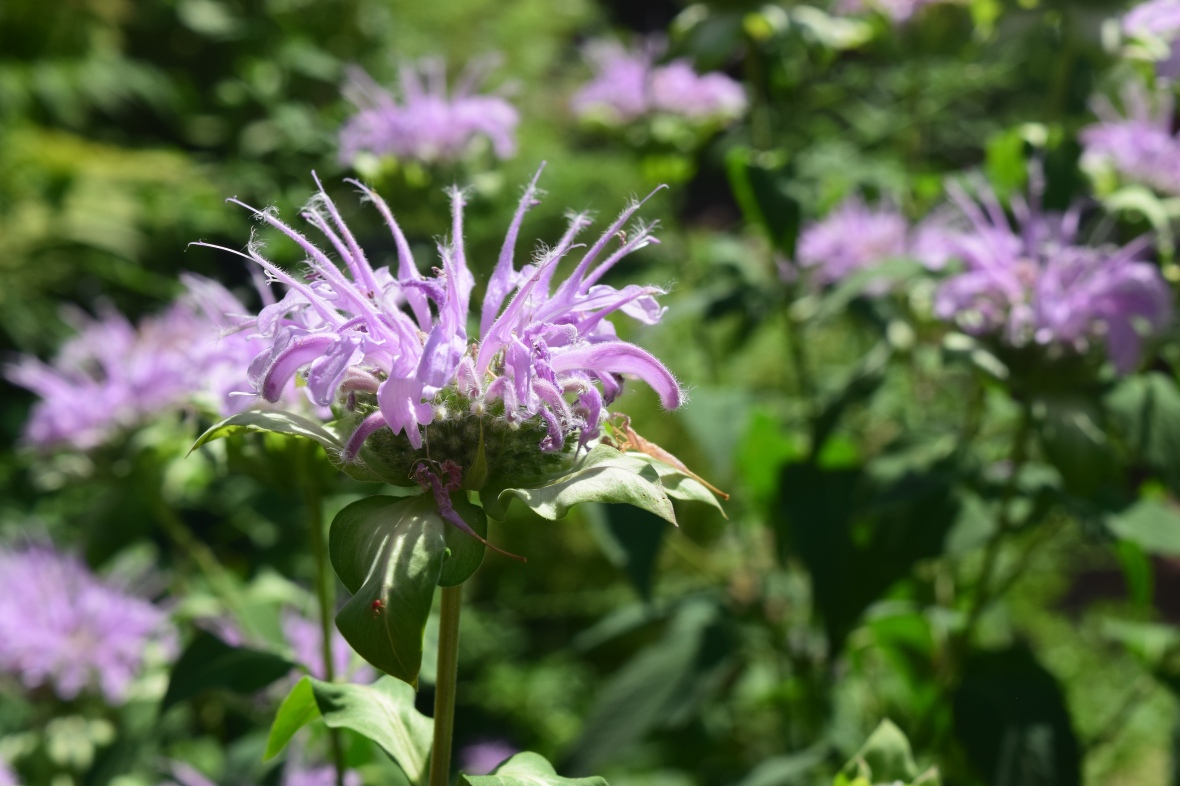
Its flowers are also smaller, but I appreciate their lavender-blue color. Downy mildew has not been a problem with the Wild Bergamot in our garden, but that experience is not universal.
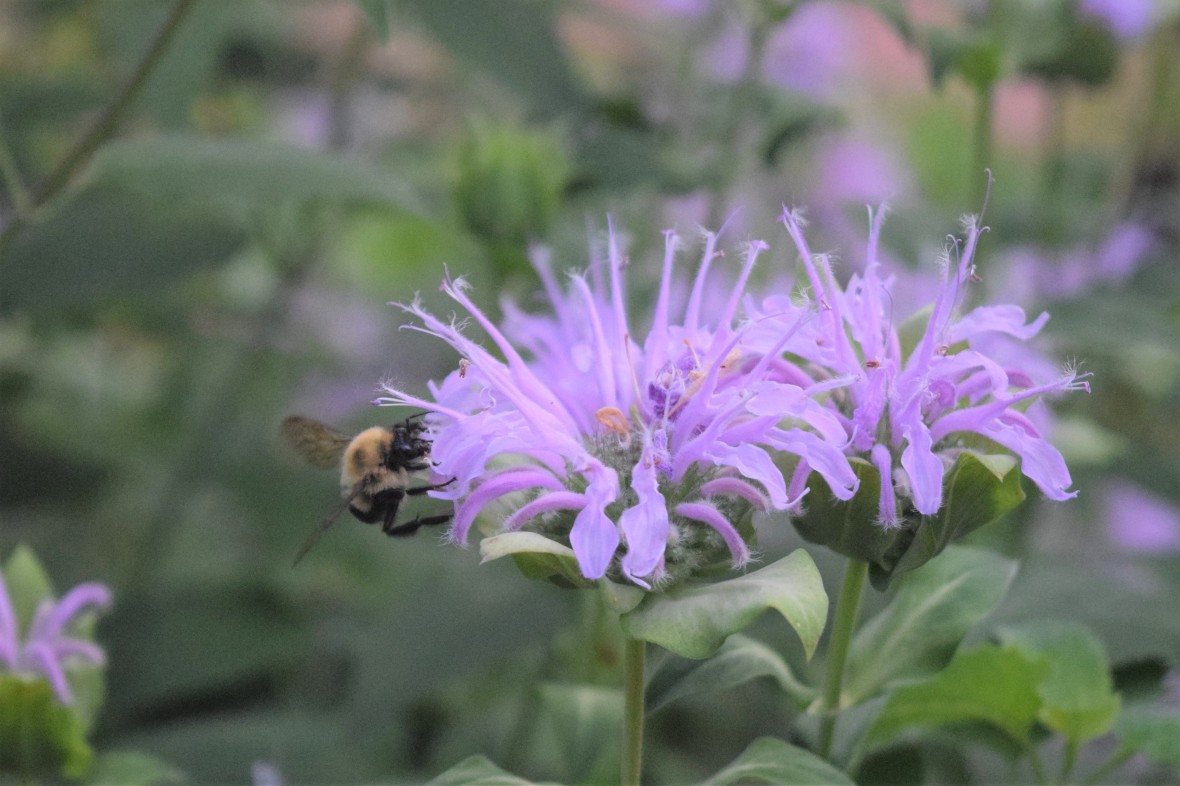
Both Bee Balm and Wild Bergamot respond well to cutting back in late May.
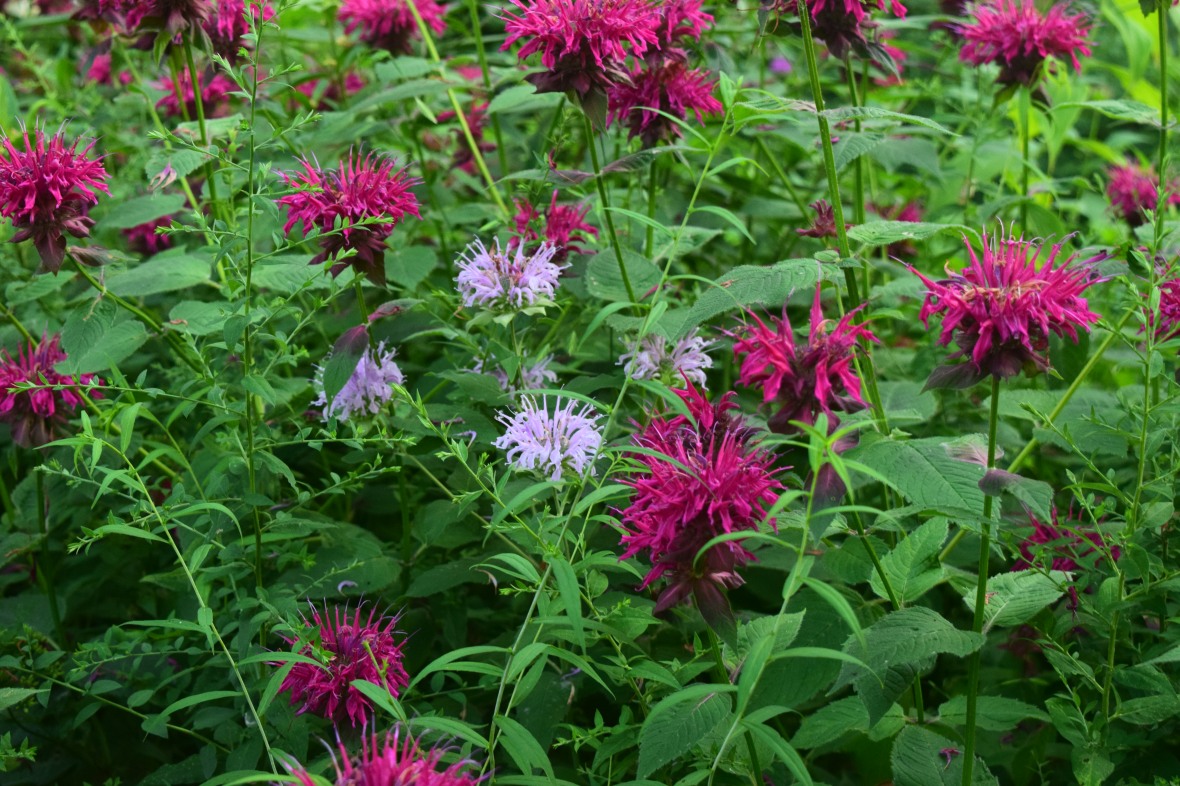
‘Purple Rooster’ is a compact variety of Wild Bergamot, growing to about 3′ tall. If I could do the Front Garden over again, I would plant ‘Purple Rooster’ in the Sidewalk Border, where the mix of plants would benefit from more mid-size species.
Another compact Monarda option is Bradbury’s Monarda (M. bradburiana), which grows to 2′ or more and is fairly adaptable in terms of sun and moisture. Sadly, I didn’t know about this species when I planted the Sidewalk Border, or it might have a prominent place there today.
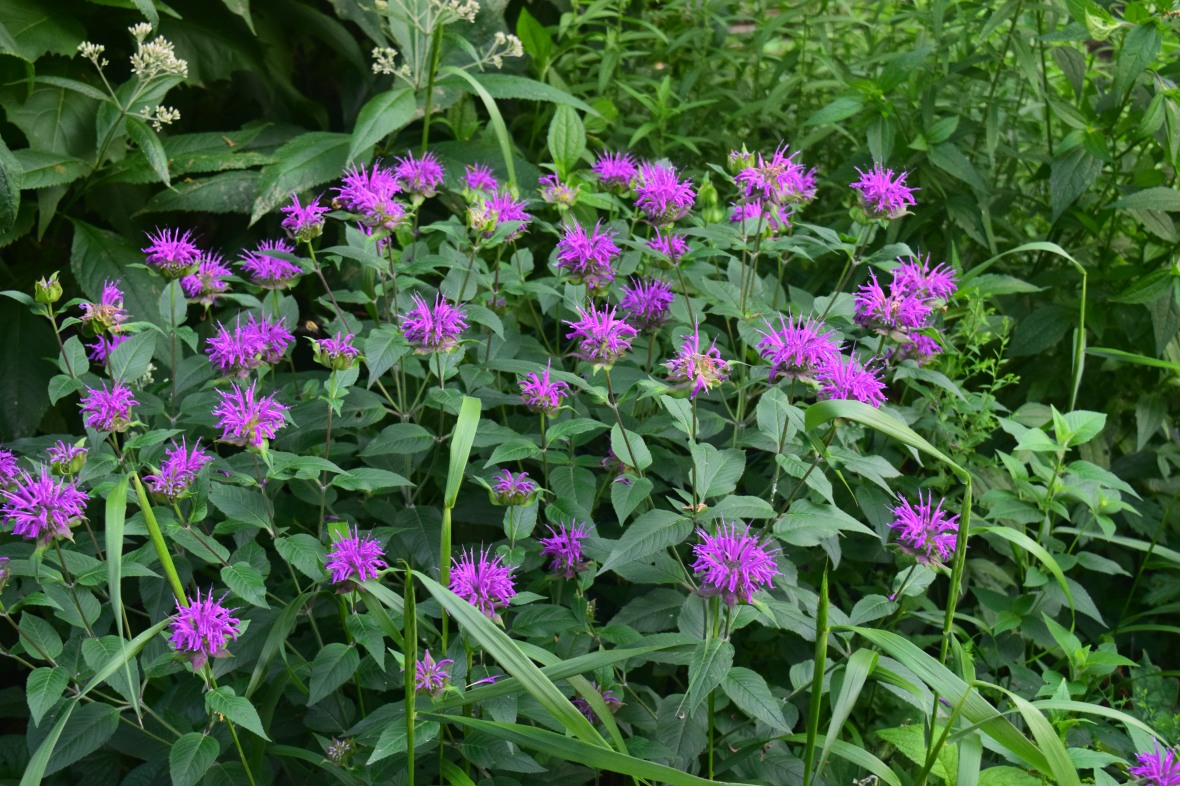
If I were starting over, ‘Raspberry Wine’ would be left to make itself at home in the Front Island Bed, which is where I put ‘Purple Rooster’. The Front Island Bed is full of other tall, aggressive plants like New England Aster (Symphyotrichum novae-angliae) and Cup Plant (Silphium perfoliatum).
There are some really short dwarf Bee Balm varieties that grow 12-18″ tall. I don’t like them, though. The flowers are too big and look out of proportion to the size of the plant.
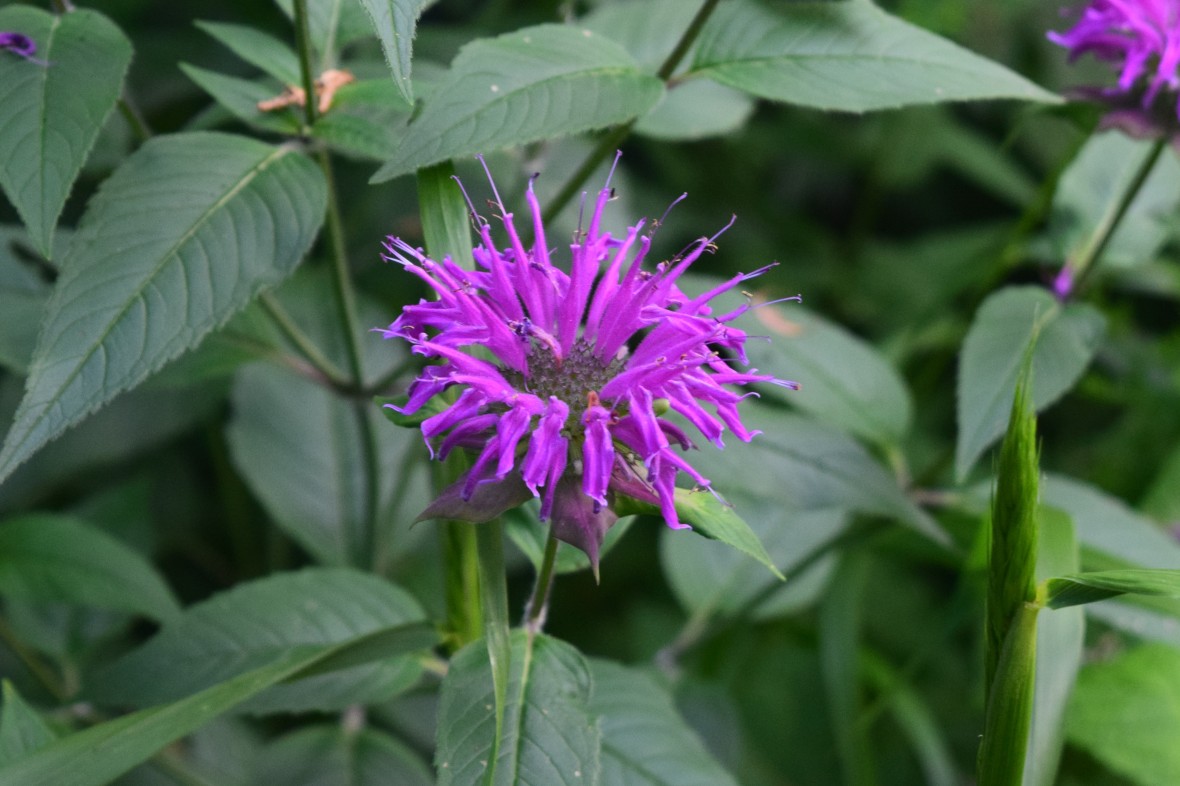
Monarda species have a substantial presence in our mid-summer garden, which is a good thing. It can be useful, though, to have a strategy to keep Bee Balm (and Wild Bergamot, to a lesser extent) from overwhelming its neighbors.






You’ve really sold me on the wild Bergamot with the bumble bee on it. Amelia
Hope it does well for you!
Monarda is a favorite of mine. I have a red one, which I need to move to a sunnier area. That raspberry wine one of yours is beautiful, and I will be on the lookout for it here, especially of it is resistant to powdery mildew.
It’s pretty popular in the Chicago area.
Love these plants. I have a hot pink monarda. The bugs love it and I love it due to its long lasting blooms and pollinator attraction. Plus this one grows in DRY mostly shade. Beckie gave it to me after starting it by seed years ago. It was just one plant I think and it has slowly grown into a nice clump only about 3′ tall. Seeing all the different hues you have makes me want more.
I guess it would grow shorter in dry conditions.
They are all so beautiful! Great photos too. Purple Rooster is my favorite shown, but do I really need another purple pollinator?
That’s is between you and your God.
Always enjoyable to hear about your experiences. I have not had the best luck with Monarda in my prairie clay — but I love it and keep trying. Purple Rooster fizzled out on me last year. Raspberry Wine is usually a consistent performer (in other people’s yards!) but I’ve had to replace it a few times. Two years ago on impulse I bought Jacob Kline, a true red with not the best reputation but, it is thriving! Go figure. I added it to my prairie where it has a lot to compete with. Of course the native species does very well in the prairie — that is the only Monarda I grow that has been a consistent performer. Oh yes, I really dislike those short versions too. They just creep me out!
Glad that ‘Jacob Kline’ has done well for you- I haven’t tried it yet.
Beautiful photos! I love Monarda–don’t have enough sun to grow it, but sure like to see it in other gardens!
It will grow in part shade, especially in a hot climate like yours.
Gorgeous photos from a great garden! I love Monarda too. I have the wild bergamot variety which doesn’t seem to be doing so well this year, neither in my yard nor in the preserves where I have seen it, but the bees still love it.
Huh. I wonder why it is having a hard time. For me it’s been pretty reliable.
I think other things are getting out of hand and I have to rescue my original plants or put in new next year.
I love it for all the reasons you mentioned. Right now, it’s the one shot of color in my backyard garden. Wish it would grow out front, but alas it doesn’t.
Too much shade?
Yes.
I like them all!
Ditto!
It was from you that I learned of “Raspberry wine” monarda, I had it in a bed in my garden that has been overtaken by bindweed. In the park bed that I tend near my home, “raspberry wine” has been going great guns for several weeks and looks good behind, gaura, muhly grass and nepeta “Six Hills Giant”. The wild monarda is also in bloom in the same patch. At the herb garden my club maintains, there is a border planting solely of the wild monarda and it is contained.
We’re suffering from the “heat dome” and the humidity doesn’t lend itself to much time weeding and deadheading and watering!
Ugh, I hope the heat passes. The nepeta sounds like a great companion for a red Monarda.
I noticed a plant at the local markets just called Monarda and, as you have mentioned this plant a few times….. I bought it!
Looking forward to seeing how it grows in spring… I’m hoping it will attract the butterflies & bees.
Hope it does well for you! If you can’t give it some place moist, I’d give it some shade.
Thanks for the tip, I’ll do that.
Wild bergamot seems like an odd name for monarda. Bergamot is a cultivar of bitter orange. I do not know if the orange or the monarda got the name first.
It’s one of those common names that has inspired a lot of confusion.
Monarda are fantastic summer flowers! They do well in my garden in dry, clay soil and don’t mind the heat and humidity. I do get powdery mildew on one variety but I can’t remember the variety. The straight species doesn’t seem to get it.
I’m glad it does well for you, and impressed that it performs well in dry clay.
Bradley’s monarda, at least here, blooms well before the midsummer varieties, so you might want to consider it as an addition, for earlier-season pollinators, rather than a replacement.
Good to know. M. fistulosa seems to bloom a little later than M. didyma so you could combine all 3 for a long Monarda display.
Beautiful! I planted a couple this spring.
I hope they do well for you!
‘Purple Rooster’ is on my wishlist, for its own qualities but also as a connection to the fabulous Flower Factory nursery. A visit on a hot July day 20 years ago is still with me.
‘Raspberry Wine’s dark bracts and rich color make it my favorite, but I’ve had good results with red ‘Jakob Cline’, too.
Flower Factory in Wisconsin?
Sometimes it surprises me to see how different the cultivated varieties are from the natives. The colors and forms are lovely. I especially enjoyed the photo of the swallowtail. I spent a half-hour chasing a pair on Sunday with no luck — I’m beginning to think gardens are easier spots to photograph them. (Or the photographers are more skilled, of course!)
A lot of butterflies are really hyperactive, it’s almost like you have to stay in one place and wait for them to come to you.
A timely post. Yesterday I had to pull more than a few Raspberry Wine plants out of one garden to make room for the stunted Blue Fortune Agastache and the pink coneflowers trying to come up underneath. As you said, Raspberry Wine Monarda is a crowding plant for sure. I do like it but will be more vigilant about keeping it where I want it.
There are a few plants that can stand up to Bee Balm: Common Milkweed, White Wild Indigo, Calico Aster, and other tall plants in the Mint Family.
I had grape gumball (one of those short versions of bee balm) and I think it interbred with my wild bergamot and now I have wild bergamot in all kinds of colors from ballet pink to fuschia, and in heights from 3-5 feet. I kinda like it.
It seems that the plants in this genus will interbreed with abandon if the opportunities arise.
I love them all, mine seem to have disappeared.xxx
Oh, that’s too bad.
Yours is a gorgeous front garden and not the least bit boring. I’m sure you’ve been an inspiration to others in your neighborhood. Lovely photos!!
I have sensed there is a growing trend around here to have more garden in the front yard and less lawn. Nice to think I may have contributed to that.